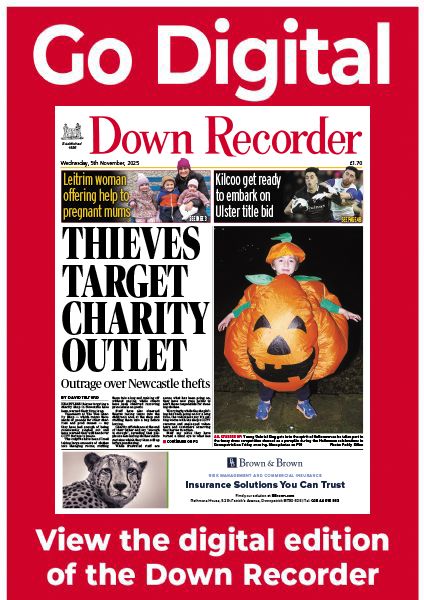Stepping back in time to uncover railway history
Stepping back in time to uncover railway history
11 January 2012 - by DAVID TELFORD
AN appeal has been launched for artefacts relating to the Belfast and Co Down Railway.
It comes on the eve of the 62nd anniversary of the closure of the railway line — which used to run from Belfast to towns including Downpatrick, Newcastle, Ardglass, Comber and Newtownards — before it was axed on January 15, 1950.
The appeal for artefacts has been issued by the Downpatrick and Co. Down Railway (DCDR). The organisation’s railway volunteer and photo archivist, Robert Gardiner, has highlighted the importance of recording and preserving things like photographs to show what life on the railway was like before the line was closed in 1950.
“We’re really the first generation that takes photos on a daily basis,” he said. “We take photos on our mobiles, we can email them and share them with hundreds of people on the internet. But back then taking photographs was not cheap; they were planned and meant to be important records of the people, buildings and trains of the day.”
Robert said the DCDR is also on the lookout for things like uniforms, tickets, posters, in fact, anything connected to the local railway. And he hopes people climbing into their lofts putting away Christmas decorations will have a look in that old trunk in the back or that old album.
Robert continued: “Photographs and memorabilia were meant to last, but all too often we find that they don’t; the people who took pictures pass away and families throw them out because they’re thought to have no historical value or importance. Indeed, everyone at the DCDR and in the wider railway fraternity knows of at least one story where something has been lost, forgotten or binned.”
Recalling one particular story, Robert said a man who took cine film of the last train pulling out of Newcastle on January 15, 1950, never let anyone copy it.
“The man passed away in the 1980s and when people enquired about obtaining the film they found that his wife had binned it, thinking no one would be interested in it. I think everyone gasps in horror when they hear that particular tale,” he continued.
“We do know that photos often show loved ones and that people often don’t want to part with them which we perfectly understand. That’s why we can offer anyone who has railway photographs the chance to have them digitally reproduced by us.”
Robert explained that although the DCDR would very much welcome original prints and negatives, there have been times when officials have gone to someone’s house and professionally scanned the images.
“This means the photos never leave people’s homes. We can also provide larger reprints of the resulting scan if anyone wants and the owners can be safe in the knowledge that their precious images have been preserved by a fully accredited museum for future generations to enjoy. So do have a rummage.”
Robert said the appeal for artefacts includes anything with a railway theme and revealed that while some people are modest when it comes to their photographs, believing they are not very good or are of poor quality, he said it’s “amazing” they exist in the first place.
The railway official said he also finds that people think that because there’s not a train in shot, that the photographs are of no interest. Robert says photos which show bridges, carriages, railway staff and passengers can be far more important historically as they show people, “the human element of the railways that all too often wasn’t recorded in official photographs, or long lost structures.”
The DCDR official revealed that recently it came across a fantastic photo collection taken by one of the Belfast and Co. Down Railway’s last cashiers, Robert Dowling, who had a keen interest in photography since the First World War and who had recorded some fantastic images of everyday life on the railway.
“His daughter Rosemary was completely surprised, but delighted that these would have been of interest and was taken aback that some of the images will form the backbone of our new display in our Carriage Gallery, due to open later this year,” Robert continued.
The railway official also outlined some of the areas not covered by existing archives that the Downpatrick & Co. Down Railway is keen to fill.
He said the BCDR carried thousands of British and American personnel during the Second World War, but yet it doesn’t have a single photograph of any UK or US forces, nor do any of its sister museums.
Robert added: “Another area we’re keen to see if anyone has recorded is the Harland & Wolff diesel engine that used to run between Downpatrick and Ardglass during the 1940s. There’s plenty of it in its later life at Great Victoria Street after the lines closed, but few of it on its native turf.
“We’re also keen to hear from anyone who has a connection to the BCDR, maybe even a member of staff that we haven’t met before. We’re keen to also record their stories and experiences to provide an oral history of the railway. Distance isn’t an issue and we can come round to where people are, whether it’s Ardglass, Newcastle, Bangor or further afield.”
Anyone with any photographs, or any other BCDR items or artefacts, or who knows someone who might be able to help is urged to contact Robert Gardiner on 078 1636 5251, email downtrains@yahoo.co.uk or write to him c/o Downpatrick & Co. Down Railway, Market Street, Downpatrick, Co. Down, BT30 6LZ.


